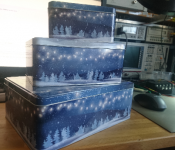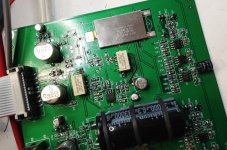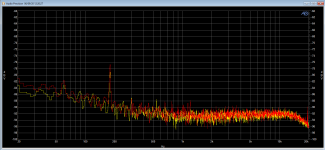I've only now read the posts re. shielding against mains hum, and thought that the experience I gained with a possibly not widely known material might be interesting.
I've built two RIAA units by Hans Polak (Linear Audio Vol. 12), each with a gain of 60dB@1kHz. Both were built into the same kind of housing - 1.5mm aluminium all around, only the front plate was 6mm thick. The individual PCBs (two per unit) were fastened on a copper-clad PCB material that extends over the entire area of the housing.
Both RIAA units had audible mains hum when placed on top of their respective preamps.
By chance, I ran across a material that in the end solved the problem:
YSHIELD(R) Magnetic field shielding film MCF5 | MF | Width 5 cm | 1 meter | YSHIELD(R) | YTHERM(R)
I covered the inside of the bottom housing plate with the foil, and repeated it on the copper side of the plate that holds the RIAA PCBs. The hum is now not audible in the loudspeakers (85dB sensitivity) after being additionally amplified by 32dB, and with the cartridge connected.
Unfortunately, I didn't make any measurements, so I can't quantify the effects. But the fact is, two layers of a 0.02mm foil solved my problem.
Hope this info is of some use.
Regards,
Braca
I've built two RIAA units by Hans Polak (Linear Audio Vol. 12), each with a gain of 60dB@1kHz. Both were built into the same kind of housing - 1.5mm aluminium all around, only the front plate was 6mm thick. The individual PCBs (two per unit) were fastened on a copper-clad PCB material that extends over the entire area of the housing.
Both RIAA units had audible mains hum when placed on top of their respective preamps.
By chance, I ran across a material that in the end solved the problem:
YSHIELD(R) Magnetic field shielding film MCF5 | MF | Width 5 cm | 1 meter | YSHIELD(R) | YTHERM(R)
I covered the inside of the bottom housing plate with the foil, and repeated it on the copper side of the plate that holds the RIAA PCBs. The hum is now not audible in the loudspeakers (85dB sensitivity) after being additionally amplified by 32dB, and with the cartridge connected.
Unfortunately, I didn't make any measurements, so I can't quantify the effects. But the fact is, two layers of a 0.02mm foil solved my problem.
Hope this info is of some use.
Regards,
Braca
I've only now read the posts re. shielding against mains hum, and thought that the experience I gained with a possibly not widely known material might be interesting.
I've built two RIAA units by Hans Polak (Linear Audio Vol. 12), each with a gain of 60dB@1kHz. Both were built into the same kind of housing - 1.5mm aluminium all around, only the front plate was 6mm thick. The individual PCBs (two per unit) were fastened on a copper-clad PCB material that extends over the entire area of the housing.
Both RIAA units had audible mains hum when placed on top of their respective preamps.
By chance, I ran across a material that in the end solved the problem:
YSHIELD(R) Magnetic field shielding film MCF5 | MF | Width 5 cm | 1 meter | YSHIELD(R) | YTHERM(R)
I covered the inside of the bottom housing plate with the foil, and repeated it on the copper side of the plate that holds the RIAA PCBs. The hum is now not audible in the loudspeakers (85dB sensitivity) after being additionally amplified by 32dB, and with the cartridge connected.
Unfortunately, I didn't make any measurements, so I can't quantify the effects. But the fact is, two layers of a 0.02mm foil solved my problem.
Yes, amorphous cobalt based materials are very good for magnetic shielding. They may have some practical disadvantages, though, I don't think it's solderable (hence needs a mechanical setup for grounding) also it is much harder that mumetal. But I see it's not that expensive, which makes it a good option for DIYers. I'll try to get some locally, without the outrageous shipping and importing fees.
P.S. Yep, it's available here: Magnetic shielding film MCF5 1 Linear Meter: Amazon.ca: Electronics Order is on it's way.
Last edited:
Does this stuff really do anything at 50Hz or 60Hz? More than 1.5mm Alu?
Jan
It seems to be working: my problem was the 50Hz induction from a transformer in the unit beneath the RIAA preamp, so there were two 1.5mm Al plates between this transformer and the RIAA electronics. Separating the two units by about 50cm eliminated the hum, i.e. produced the same effect as the two foils placed into the RIAA housing.
There is a diagram on the page with the foil that shows 30dB attenuation at low frequencies. This diagram prompted my bying the stuff.
Regards,
Braca
Does this stuff really do anything at 50Hz or 60Hz? More than 1.5mm Alu?
Looks pretty good to me.
1.5mm of aluminum @60Hz does virtually nothing, since it is not thick enough to rely on the eddy currents cancelling the inbound magnetic field.
Attachments
Last edited:
Ah, the Pdf I opened didn't have that bit. Well worth having unless you are Hans and living in an area of outstanding lack of LF fields 🙂
I once saw a shielded room at the PTB in Berlin that they
claimed was the electromagnetically quietest place on earth,
with a size that you could go into it. There were quieter ones,
but smaller.
7 layers of mu metal, apparently quite thin + alu box for support.
They used it to measure 3d brain currents, contactless with arrays of squids.
< 8.22 Metrology of Ultra-Low Magnetic Fields - PTB.de >
In the last xmas season, I scored these tin boxes, intended to
package presents. They were just €2, together.
Probably much better in dB/€ than most everything else.
claimed was the electromagnetically quietest place on earth,
with a size that you could go into it. There were quieter ones,
but smaller.
7 layers of mu metal, apparently quite thin + alu box for support.
They used it to measure 3d brain currents, contactless with arrays of squids.
< 8.22 Metrology of Ultra-Low Magnetic Fields - PTB.de >
In the last xmas season, I scored these tin boxes, intended to
package presents. They were just €2, together.
Probably much better in dB/€ than most everything else.
Attachments
Last edited:
In the last xmas season, I scored these tin boxes, intended to package presents. They were just €2, together.
Welcome to Richard's Duraglit world.
ADI' Linear Tech application note -- the matryoshka doll mains noise reduction method: https://www.analog.com/media/en/technical-documentation/application-notes/an159fa.pdf copper box inside a mu-metal box inside a cookie tin.
I have the luxury of a sheet metal brake. the 3# coffee containers from costco can be refashioned into very effective shields...and the Dremel tool takes care of removing the varnish.
I have the luxury of a sheet metal brake. the 3# coffee containers from costco can be refashioned into very effective shields...and the Dremel tool takes care of removing the varnish.
Figure 9 is superb. I can't remember the last time I soldered up a box from copper clad. I really must start doing some prototyping again 😀
Tested just for fun: My cell phone does not ring if I put it into the triple box. 
Without removing any paint.

Without removing any paint.
Figure 9 is superb. I can't remember the last time I soldered up a box from copper clad. I really must start doing some prototyping again 😀
The mumetal box in Fig. 7 looks very professionally machined. I wonder if they annealed it after machining.
OTOH, the setup looks quite extreme to me, for measuring 2nV/rtHz with 5% precision (as originally stated). They got the amplifier to 0.45nV/rtHz (for 1% precision), but I don't really see why they went through the pain of building a low noise discrete stage in front of a mediocre opamp, then paralleling four of them. They could simply parallel 4 low noise opamps like the ADA4898 for the same result. Wait, it could be that Linear Technology did not have a <1nV/rtHz opamp at the time?
P.S. No they did. LT1115, LT1028/1128 are in production since the beginning of time...
Last edited:
They have the LT1028 since an eternity, same league.
It just has a noise molehill at 350 KHz.
It just has a noise molehill at 350 KHz.
What's the circuit?for those about to use high-value caps
here are Nichicon UVK 33000uF (red trace) and AVX Bestcap (yellow trace) 100000uF in 8xBF862 feedback network
- Home
- Source & Line
- Analogue Source
- Richard Lee's Ultra low Noise MC Head Amp



